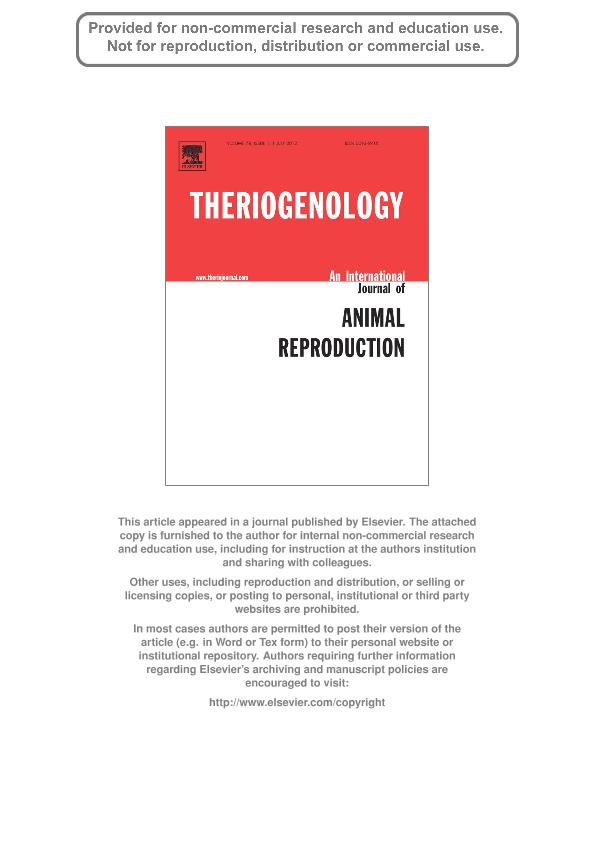Mostrar el registro sencillo del ítem
dc.contributor.author
Bevacqua, Romina Jimena

dc.contributor.author
Pereyra Bonnet, Federico Alberto

dc.contributor.author
Olivera, Ramiro
dc.contributor.author
Hiriart, María Inés

dc.contributor.author
Sipowicz, Pablo
dc.contributor.author
Fernández y Martín, Rafael

dc.contributor.author
Radrizzani Helguera, Martin

dc.contributor.author
Salamone, Daniel Felipe

dc.date.available
2017-05-11T20:48:06Z
dc.date.issued
2012-07
dc.identifier.citation
Bevacqua, Romina Jimena; Pereyra Bonnet, Federico Alberto; Olivera, Ramiro; Hiriart, María Inés; Sipowicz, Pablo; et al.; Production of IVF transgene-expressing bovine embryos using a novel strategy based on cell cycle inhibitors; Elsevier Science Inc; Theriogenology; 78; 1; 7-2012; 57-68
dc.identifier.issn
0093-691X
dc.identifier.uri
http://hdl.handle.net/11336/16349
dc.description.abstract
The objective was to evaluate the effects of cell cycle inhibitors (6-dimethylaminopurine [DMAP], and dehydroleukodine [DhL]) on transgene expression efficiency and on mosaic expression patterns of IVF bovine zygotes cytoplasmically injected with oolema vesicles coincubated with transgene. The DNA damage induced by the transgene or cell cycle inhibitors was measured by detection of phosphorylated histone H2AX foci presence (marker of DNA double-stranded breaks). Cloning of egfp blastomeres was included to determine continuity of expression after additional rounds of cellular division. The pCX-EGFP [enhanced green fluorescent protein gene (EGFP) under the chimeric cytomegalovirus IE-chicken-β-actin enhancer promoter control] gene plasmid (50 ng/μL) was injected alone (linear or circular exogenous DNA, leDNA and ceDNA, respectively) or associated with ooplasmic vesicles (leDNA-v or ceDNA-v). The effects of 2 mm DMAP or 1 μm DhL for 6 h (from 15 to 21 h post IVF) was evaluated for groups injected with vesicles. The DMAP increased (P < 0.05) egfp homogenous expression relative to transgene alone (21%, 18%, and 11% for leDNA-v + DMAP, leDNA-v, and leDNA, respectively) and also increased (P < 0.05) the phosphorylated histone H2AX foci area. Expression of egfp was higher (P < 0.05) for linear than for circular pCX-EGFP, and egfp blastocyst rates were higher (P < 0.05) for groups injected with linear transgene coincubated with vesicles than for linear transgene alone (95%, 77%, 84%, and 52% for leDNA-v + DMAP, leDNA-v + DhL, leDNA-v, and leDNA, respectively). Moreover, DMAP tended to improve egfp blastocysts rates for both circular and linear transgenes. Based on fluorescent in situ hybridization (FISH) analysis, there was evidence of integration in egfp embryos. Finally, clones derived from leDNA-v + DMAP had the highest egfp expression rates (96%, 65%, and 65% for leDNA-v + DMAP, leDNA-v, and leDNA, respectively). Transgenesis by cytoplasmic injection of leDNA-v + DMAP is a promising alternative for transgenic animal production.
dc.format
application/pdf
dc.language.iso
eng
dc.publisher
Elsevier Science Inc

dc.rights
info:eu-repo/semantics/openAccess
dc.rights.uri
https://creativecommons.org/licenses/by-nc-nd/2.5/ar/
dc.subject
6-Dimethylaminopurine
dc.subject
Dehydroleukodine
dc.subject
Transgenesis
dc.subject
Phosphorylated
dc.subject.classification
Biología Reproductiva

dc.subject.classification
Ciencias Biológicas

dc.subject.classification
CIENCIAS NATURALES Y EXACTAS

dc.title
Production of IVF transgene-expressing bovine embryos using a novel strategy based on cell cycle inhibitors
dc.type
info:eu-repo/semantics/article
dc.type
info:ar-repo/semantics/artículo
dc.type
info:eu-repo/semantics/publishedVersion
dc.date.updated
2017-05-08T21:18:34Z
dc.journal.volume
78
dc.journal.number
1
dc.journal.pagination
57-68
dc.journal.pais
Estados Unidos

dc.description.fil
Fil: Bevacqua, Romina Jimena. Universidad de Buenos Aires. Facultad de Agronomía. Pabellón de Zootecnica. Laboratorio de Biotecnología Animal; Argentina. Consejo Nacional de Investigaciones Científicas y Técnicas; Argentina
dc.description.fil
Fil: Pereyra Bonnet, Federico Alberto. Universidad de Buenos Aires. Facultad de Agronomía. Pabellón de Zootecnica. Laboratorio de Biotecnología Animal; Argentina. Consejo Nacional de Investigaciones Científicas y Técnicas; Argentina
dc.description.fil
Fil: Olivera, Ramiro. Universidad de Buenos Aires. Facultad de Agronomía. Pabellón de Zootecnica. Laboratorio de Biotecnología Animal; Argentina
dc.description.fil
Fil: Hiriart, María Inés. Universidad de Buenos Aires. Facultad de Agronomía. Pabellón de Zootecnica. Laboratorio de Biotecnología Animal; Argentina. Consejo Nacional de Investigaciones Científicas y Técnicas; Argentina
dc.description.fil
Fil: Sipowicz, Pablo. Universidad Nacional de San Martín. Escuela de Ciencia y Tecnología. Centro de Estudios en Salud y Medio Ambiente. Laboratorio de Neuro y Citogenética Molecular; Argentina
dc.description.fil
Fil: Fernández y Martín, Rafael. Universidad de Buenos Aires. Facultad de Agronomía. Pabellón de Zootecnica. Laboratorio de Biotecnología Animal; Argentina. Consejo Nacional de Investigaciones Científicas y Técnicas; Argentina
dc.description.fil
Fil: Radrizzani Helguera, Martin. Universidad Nacional de San Martín. Escuela de Ciencia y Tecnología. Centro de Estudios en Salud y Medio Ambiente. Laboratorio de Neuro y Citogenética Molecular; Argentina. Consejo Nacional de Investigaciones Científicas y Técnicas; Argentina
dc.description.fil
Fil: Salamone, Daniel Felipe. Universidad de Buenos Aires. Facultad de Agronomía. Pabellón de Zootecnica. Laboratorio de Biotecnología Animal; Argentina. Consejo Nacional de Investigaciones Científicas y Técnicas; Argentina
dc.journal.title
Theriogenology

dc.relation.alternativeid
info:eu-repo/semantics/altIdentifier/doi/http://dx.doi.org/10.1016/j.theriogenology.2012.01.020
dc.relation.alternativeid
info:eu-repo/semantics/altIdentifier/url/http://www.sciencedirect.com/science/article/pii/S0093691X12000556
Archivos asociados
